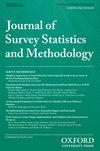探索通过智能手机招募受访者和收集网络数据的可行性:以德国普通人口调查的文本到网络招聘为例
IF 1.6
4区 数学
Q2 SOCIAL SCIENCES, MATHEMATICAL METHODS
引用次数: 1
摘要
智能手机的广泛使用及其技术特点为调查研究提供了许多机会。因此,智能手机调查的重要性和受欢迎程度正在稳步上升。为了探索一种新的文本到网络方法直接通过智能手机对人们进行调查的可行性,我们在德国进行了一项案例研究,通过短信从移动随机数字拨号样本中招募了受访者,其中包括网络调查的链接。我们表明,尽管这种调查方法是可行的,但它受到了一些问题的阻碍,即在邀请阶段的数字损失很大,以及在调查的登录页上隐性拒绝的比率很高。本文章由计算机程序翻译,如有差异,请以英文原文为准。
Exploring the Feasibility of Recruiting Respondents and Collecting Web Data Via Smartphone: A Case Study of Text-To-Web Recruitment for a General Population Survey in Germany
The widespread usage of smartphones, as well as their technical features, offers many opportunities for survey research. As a result, the importance and popularity of smartphone surveys is steadily increasing. To explore the feasibility of a new text-to-web approach for surveying people directly via their smartphones, we conducted a case study in Germany in which we recruited respondents from a mobile random digit dialing sample via text messages that included a link to a web survey. We show that, although this survey approach is feasible, it is hampered by a number of issues, namely a high loss of numbers at the invitation stage, and a high rate of implicit refusals on the landing page of the survey.
求助全文
通过发布文献求助,成功后即可免费获取论文全文。
去求助
来源期刊
CiteScore
4.30
自引率
9.50%
发文量
40
期刊介绍:
The Journal of Survey Statistics and Methodology, sponsored by AAPOR and the American Statistical Association, began publishing in 2013. Its objective is to publish cutting edge scholarly articles on statistical and methodological issues for sample surveys, censuses, administrative record systems, and other related data. It aims to be the flagship journal for research on survey statistics and methodology. Topics of interest include survey sample design, statistical inference, nonresponse, measurement error, the effects of modes of data collection, paradata and responsive survey design, combining data from multiple sources, record linkage, disclosure limitation, and other issues in survey statistics and methodology. The journal publishes both theoretical and applied papers, provided the theory is motivated by an important applied problem and the applied papers report on research that contributes generalizable knowledge to the field. Review papers are also welcomed. Papers on a broad range of surveys are encouraged, including (but not limited to) surveys concerning business, economics, marketing research, social science, environment, epidemiology, biostatistics and official statistics. The journal has three sections. The Survey Statistics section presents papers on innovative sampling procedures, imputation, weighting, measures of uncertainty, small area inference, new methods of analysis, and other statistical issues related to surveys. The Survey Methodology section presents papers that focus on methodological research, including methodological experiments, methods of data collection and use of paradata. The Applications section contains papers involving innovative applications of methods and providing practical contributions and guidance, and/or significant new findings.

 求助内容:
求助内容: 应助结果提醒方式:
应助结果提醒方式:


